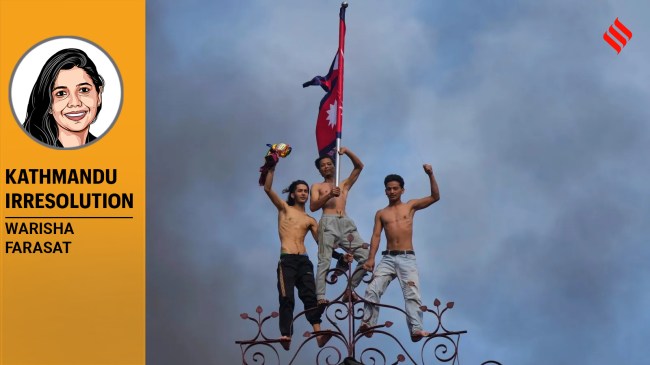Opinion In Nepal, Gen Z’s revolt is rooted in years of betrayal, inequality and failure to deliver on promises
Unless historical injustices are redressed, and inequalities seriously addressed, lasting peace is never a possibility.
 Protesters celebrate standing at the top of the Singha Durbar, the seat of Nepal's government's various ministries and offices, after it was set on fire during a protest against social media ban and corruption in Kathmandu, Nepal, Tuesday, Sept. 9, 2025. (AP Photo/Niranjan Shrestha)
Protesters celebrate standing at the top of the Singha Durbar, the seat of Nepal's government's various ministries and offices, after it was set on fire during a protest against social media ban and corruption in Kathmandu, Nepal, Tuesday, Sept. 9, 2025. (AP Photo/Niranjan Shrestha) The youth uprising in Nepal has an uncanny resemblance to the Arab Spring. While the immediate trigger for the Nepal protests appear to be the shutting down of social media by the government, the actual cause for this mass uprising is deeper and complex and can only be understood by scanning through the recent history of this Himalayan nation. Similarly, while the immediate trigger for the Egyptian Revolution in January 2011 was the uprising in Tunisia, the downfall of President Hosni Mubarak was aided by multiple factors. For one, the progressive and democratic forces in the country had been pushing for a freer society for years. Then the simmering economic crisis in the country escalated with an exponential increase in the IMF debt and a dismantling of the public sector, which was replaced by a private sector controlled by Mubarak, his son, and their cronies. This enraged the Egyptian army leadership who had supported Mubarak unconditionally. They were particularly irritated by Mubarak’s efforts to install his own son Gamal as his replacement as the head of the state. Mubarak’s wife was reviled by the public for her lavish lifestyle funded by the proceeds of blatant corruption and her role in the theft of precious Egyptian archaeological and cultural artefacts.
Not long ago, Nepal, too, witnessed a bloody conflict by the Maoists who challenged not only the monarchy but also the entrenched feudal structures within the Nepali society. This conflict started in 1996 when the Maoists launched a nationwide insurgency to overthrow the monarchy and turn the Himalayan kingdom into a people’s republic. It eventually turned into a full-fledged civil war that ravaged Nepali society for a decade.
I remember listening to UN Human Rights Commissioner Michelle Bachelet in Kathmandu where she addressed a full house after the signing of the Comprehensive Peace Agreement (CPA) in November 2006 between the Maoists and the government of Nepal, bringing an end to the 10-year long conflict. Indeed, it was a historic moment, and we were sitting in a room full of hope for peace and justice.
Like any other Peace Agreement, however, the CPA was not a perfect document. Nonetheless, it reiterated a solemn commitment given by the warring parties to uphold civil liberties, respect for human rights, fundamental freedoms, democratic governance and the rule of law. Moreover, the CPA provided for the formation of a Truth and Reconciliation Commission and a Commission of Investigation on Enforced Disappeared Persons (CIEDP) to address serious human rights violations, identify the root causes of the conflict, and provide justice and reparation to the victims. A new Nepali constitution replacing the Interim Constitution (2007) was promulgated in 2015, which was premised on secularism and federalism.
A decade later, it is clear that none of the promises made in the CPA have been kept. While the fighting ceased after the 2006 accord, there was no appetite for addressing the equally important issues raised in the CPA across parties. The transitional justice mechanisms to address the root causes of conflict and provide for reparations, justice, and reconciliation have been mired in controversy for failing to comply with international standards, particularly for providing amnesties for serious human rights violations. The Truth and Reconciliation Commission and CIEDP were amended only in 2024 to reflect the concerns of the civil society and victim groups. A new set of commissioners were appointed in May 2025, and obviously, the commissions, which have a four-year mandate, have not yet accomplished much. The root causes of the conflict such as inequitable distribution of wealth, historical inequalities, glaring social and economic injustices, justice and reparations for conflict victims remain largely unaddressed.
It is against this backdrop that the recent protests need to be understood. These protests have not simply emerged out of thin air. The signing of the CPA had brought with it unprecedented attention and resources to Nepal. Seventeen years later, it is evident that the political leaders have squandered precious resources that should have been used for rebuilding lasting peace and an equitable society.
The Gen Z protests have been defined by their anger against the corruption of the Nepali elite who lead luxurious lives unlike the average Nepali who has to struggle even for his/her basic needs. Unemployment is at an all-time high. According to the
World Bank, unemployment was at 20 per cent last year. The per capita income in Nepal is $1,400.
There are scores of videos on social media with hashtags like NepoKids and NepoBabies arguing that the children of the ruling elite succeed because of the privileges and wealth accumulated through corruption by their parents and not through hard work. In fact, this “nepo kid” characterisation encompasses the failure of the post-conflict mechanism to reverse historical class and caste inequalities. It is ironic that the 10-year conflict that culminated in the CPA in 2006 had also started out as a movement against the entrenched inequalities in Nepal. “Poonjipati” or businessmen were derided during the Maoist conflict as they symbolised the concentration of wealth in the hands of a few. The failure of consecutive governments in Kathmandu to investigate several of the major corruption cases and prosecute the guilty only added fuel to fire. The youth are especially convinced that the ruling elite protects the corrupt because it is rampant across the political spectrum.
There is a lesson to be learnt here. Penning a historical peace agreement only provides a buffer and not a permanent solution to the problems faced by the country. The 2006 peace agreement that ended the fighting was, in fact, only the beginning of the process and not its end. An honest implementation of the promises made was as essential as the cessation of hostilities between the warring parties. Unless historical injustices are redressed, and inequalities seriously addressed, lasting peace is never a possibility.
The writer, a Delhi-based lawyer, previously worked at the International Center for Transitional Justice, New York






